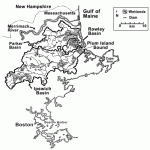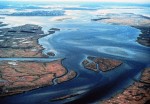Human activities in rivers and watersheds have altered enormously the timing, magnitude and nature of inputs of materials such as water, sediments, nutrients and organic matter to estuaries (Hopkinson and Vallino 1995). One of the dominant themes of estuarine research in recent decades has been the effects of inorganic nutrients on eutrophication of coastal waters. Studies have detailed how inorganic nutrient inputs from land influence primary productivity, the depletion of oxygen, habitats, and trophic relationships in coastal waters. However, another important but neglected linkage between land and coastal waters is the input of dissolved and particulate organic carbon and organic nitrogen.
Organic nitrogen inputs are frequently greater than inorganic nitrogen inputs and in many cases the input of organic carbon from land is greater than the in situ production of organic carbon. Despite the quantitative importance of organic matter inputs from land, there are few data on its actual use in coastal waters and even fewer on effects of organic matter loading on coastal ecosystem trophic structure and trophic productivity. Yet, in other ecosystems such as rivers, lakes, and the deep-sea, effects of allochthonous organic matter inputs on trophic structure and ecosystem metabolism have been well documented.
Climate variability and long-term patterns of climate change also can have immense effects on the timing, magnitude and nature of material inputs. Infrequent storms can accomplish in days what normally occurs over decades. For instance, heavy rainfall associated with tropical storm Agnes increased Susquehanna River flow to record levels, which resulted in 30 years of "normal" sediment discharge occurring in one week (Hirshberg and Schubel 1979).
Variations and long-term increases in sea level affect estuaries from their seaward end. Tides and sea level have significant effects on water and marsh sediment salinity, plant community composition (Olff et al. 1988), primary production (Morris and Haskin 1990, Morris 1995), access to marsh surface habitats by nekton (Rozas 1995) and sediment accretion (Callaway et al. 1996).
The interaction of organic matter and nutrient inputs from land and variations in the external forcings (climate, land use, river discharge, sea level) regulating estuarine mixing and residence time will dictate the extent of nutrient and organic matter processing during estuarine transport and will determine the spatial patterns of productivity and trophic structure.
The study will be conducted in three land-margin ecosystems. Primary focus is the Plum Island Sound Ecosystem where research will be conducted in watersheds and estuaries. Comparative research will be conducted in two other estuaries enabling us to test responses within and across biogeographic provinces and climatic regions. Wells Estuary in Maine, and North Inlet estuary in South Carolina are part of the NOAA National Estuarine Research Reserve network. While all three systems have extensive bordering inter-tidal marshes and approximately equivalent ratios of marsh to water, the freshwater runoff ranges from being almost insignificant in North Inlet, to moderate in Plum Island and large in Wells.
Plum Island Sound
Charles Hopkinson, Jr., Principal Investigator
The Ecosystems Center
Marine Biological Laboratory
Woods Hole, MA 02543
http://www.mbl.edu/html/ECOSYSTEMS/lmer/plumisla/plumisla.html

 Enlarge this image
Enlarge this image
